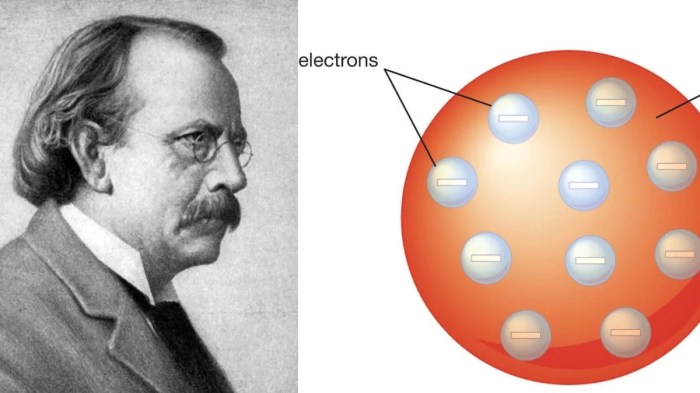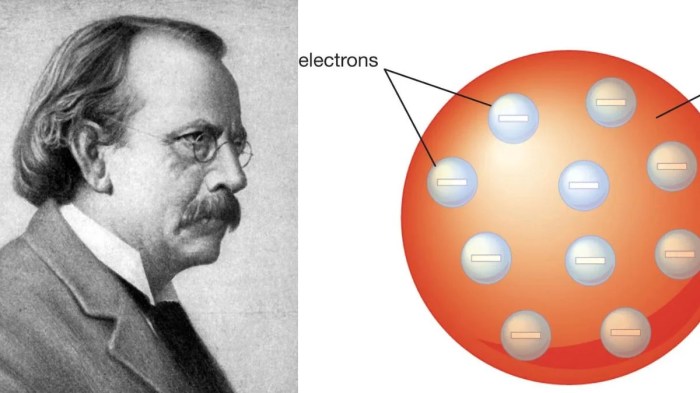Who discovered electrons – The discovery of electrons marked a pivotal moment in our understanding of the fundamental building blocks of matter. This journey began with the groundbreaking experiments of J.J. Thomson and culminated in Robert Millikan’s precise determination of the electron’s charge.
Thomson’s cathode ray experiments revealed the existence of a subatomic particle with a negative charge, which he named the “electron.” Millikan’s oil drop experiment, conducted a decade later, provided a more accurate measurement of the electron’s charge, confirming its fundamental nature.
Historical Timeline of Electron Discovery
The understanding of electrons, the fundamental particles that carry negative electrical charges, has evolved through a series of key discoveries and experiments. Here is a detailed timeline of these milestones:
William Crookes’ Experiments
- In 1875, British physicist William Crookes conducted experiments with cathode rays, which were streams of electrons emitted from a negatively charged electrode in a vacuum tube.
- Crookes observed that cathode rays could travel in straight lines, cast shadows, and cause fluorescence in certain materials.
J.J. Thomson’s Discovery of Electrons
- In 1897, British physicist J.J. Thomson conducted experiments with cathode rays and discovered that they consisted of tiny particles, which he called “corpuscles” and are now known as electrons.
- Thomson measured the charge-to-mass ratio of electrons and found that it was much smaller than that of any known atom.
Robert Millikan’s Oil Drop Experiment
- In 1909, American physicist Robert Millikan conducted the oil drop experiment, which allowed him to determine the charge of a single electron.
- Millikan measured the motion of charged oil droplets in an electric field and found that their charges were always multiples of a fundamental unit of charge, which was the charge of an electron.
Later Developments
- In the early 20th century, scientists continued to study electrons and their properties.
- In 1924, French physicist Louis de Broglie proposed that electrons have wave-like properties, which was later confirmed by experiments.
- In the 1920s and 1930s, quantum mechanics developed, which provided a theoretical framework for understanding the behavior of electrons and other subatomic particles.
J.J. Thomson’s Experiments
J.J. Thomson conducted a series of cathode ray experiments in the late 19th century, which led to the discovery of the electron. These experiments involved passing an electric current through a vacuum tube, creating a beam of cathode rays.
Thomson’s experiments demonstrated that cathode rays were composed of negatively charged particles, which he called electrons. He also determined the electron-to-mass ratio (e/m) by measuring the deflection of the cathode rays in a magnetic field.
Electron-to-Mass Ratio (e/m)
The electron-to-mass ratio (e/m) is a fundamental physical constant that represents the ratio of the electric charge of an electron to its mass. Thomson’s experiments allowed him to determine the value of e/m with great accuracy, which was a significant breakthrough in understanding the nature of electrons.
Robert Millikan’s Oil Drop Experiment
Robert Millikan’s oil drop experiment was a groundbreaking experiment in physics that determined the charge of an electron. The experiment was conducted in 1909 and involved suspending a charged oil drop between two charged plates. By measuring the force on the oil drop, Millikan was able to calculate the charge of an electron.Millikan’s experiment was a major breakthrough in physics because it provided the first accurate measurement of the charge of an electron.
This measurement was essential for the development of atomic theory and quantum mechanics.
Experimental Setup and Methodology
Millikan’s oil drop experiment was conducted using a simple apparatus that consisted of two charged plates, an oil atomizer, and a microscope. The oil atomizer was used to create a fine mist of oil droplets. The droplets were then charged by passing them through a region of ionized air.The charged oil droplets were then introduced into the space between the two charged plates.
The electric field between the plates caused the charged oil droplets to move. Millikan used a microscope to observe the movement of the oil droplets.By measuring the velocity of the oil droplets, Millikan was able to calculate the force on the droplets.
The force on the droplets was due to the electric field between the plates and the gravitational force on the droplets.Millikan found that the force on the oil droplets was proportional to the charge on the droplets. This allowed him to calculate the charge of an electron.
Results and Significance
Millikan’s oil drop experiment showed that the charge of an electron is always a multiple of a fundamental unit of charge. This unit of charge is now known as the elementary charge. The elementary charge is equal to 1.602 × 10^-19 coulombs.Millikan’s experiment was a major breakthrough in physics because it provided the first accurate measurement of the charge of an electron.
This measurement was essential for the development of atomic theory and quantum mechanics.
The Electron’s Properties and Characteristics
Electrons, the fundamental building blocks of matter, possess unique properties that shape the behavior of atoms and determine the interactions between them.
Charge and Mass
Electrons carry a negative electrical charge, equal in magnitude but opposite in sign to the positive charge of protons. This inherent charge enables electrons to interact with electric fields and other charged particles. Electrons have an extremely small mass, approximately 1/1836 the mass of a proton.
This low mass contributes to their high mobility and plays a crucial role in atomic and molecular dynamics.
Spin
Electrons possess an intrinsic angular momentum known as spin. Spin is a quantum property that can take two orientations, “up” or “down.” This intrinsic property is crucial for understanding the behavior of electrons in atoms and the formation of chemical bonds.
Role in Atomic Structure and Chemical Bonding, Who discovered electrons
Electrons occupy specific energy levels within atoms, forming electron shells. The arrangement of electrons in these shells determines the chemical properties of elements. Electrons participate in chemical bonding by forming covalent bonds, sharing electron pairs between atoms. These bonds hold atoms together, creating molecules and compounds.
Applications of Electron Science: Who Discovered Electrons

Electron science has revolutionized various fields through its practical applications.Electron microscopy enables visualization of materials at the atomic level, aiding in research and development across disciplines like materials science, biology, and medicine. Electron beam lithography allows for precise fabrication of micro- and nanostructures, crucial for advancements in electronics and optics.
Particle Accelerators
Particle accelerators utilize electron beams to propel charged particles to high energies, enabling groundbreaking discoveries in physics and medicine. These accelerators are used in high-energy physics experiments, medical imaging, and cancer treatment.
Concluding Remarks
The discovery of electrons revolutionized our understanding of atomic structure and paved the way for advancements in fields such as electronics, particle physics, and microscopy. Today, electrons continue to be at the heart of scientific research and technological innovation, shaping our understanding of the universe and driving progress in countless industries.






